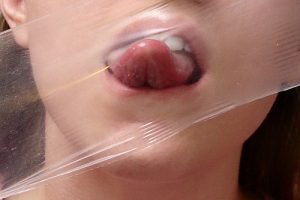Introduction
 A dental dam is a thin sheet of Latex or similar material used to protect the mouth. Dentists use them with holes punched in them to clean your teeth. They can also be used as a hygenic barrier during intimate mouth-to-whatever contact (Vagina, Anus, Eyeball, Ear, etc.)
A dental dam is a thin sheet of Latex or similar material used to protect the mouth. Dentists use them with holes punched in them to clean your teeth. They can also be used as a hygenic barrier during intimate mouth-to-whatever contact (Vagina, Anus, Eyeball, Ear, etc.)
Before You Use a Dental Dam
First, acquire a dam (from your favorite sex shop, a dentist friend, mail-order catalog, etc.) A dental dam can also be created using a condom.
Warning Dams are usually made from Latex (natural rubber) if you are your partner is sensitized to Latex, make sure you purchase one that is made from a latex alternative, or else painful swelling, burning, and other miserable reactions may occur.
Prepare the dam for use. You may wish to rinse it off to eliminate any foul-tasting powder residue from the dam’s manufacture. Then check the dam for integrity so no body fluids, STD or infection will be transmitted from one body part to another. This entails grasping the dam and stretching it to expose any holes which should become visible when stretched.
Alternatively, you may playfully attempt to inflate the dam by making the “ok” sign with your hand, placing the dam over the circlet made by your thumb and forefinger, and blowing into it, if the makeshift balloon loses air from a hole, get a new dam. Note the side your mouth was on to ensure sanitation.
Use of the Dam
Apply the dam to the desired orifice. An unlubricated dam, much like an unlubricated condom, can really rub your partner the wrong way, (Unless you’re into that sort of thing) so use some water-based lubricant (Oil-based lube will compromise the structure of the dam and it may rip).
Secure the dam. This may be as simple as using you or your partner’s hands to keep it in position. Remember the purpose of the dam is to prevent the cross-contamination of fluids, so do not pick it up halfway through and flip it over.
Perform whatever sordid acts you can come up with, some suggestions include cunnilingus and analingus. The thinness of the dam allows for the majority of sensations to be transmitted with less risk.















